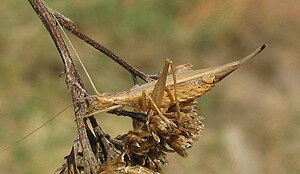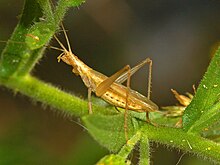Wine chicken
| Wine chicken | ||||||||||||
|---|---|---|---|---|---|---|---|---|---|---|---|---|

Female wine chicken |
||||||||||||
| Systematics | ||||||||||||
|
||||||||||||
| Scientific name | ||||||||||||
| Oecanthus pellucens | ||||||||||||
| ( Scopoli , 1763) |
The wine chickens ( Oecanthus pellucens ) are long-feelers , among them the only flower cricket in Central Europe. In southern Europe there is also the closely related and very similar species Oecanthus dulcisonans .
features
The wine-chick reaches a size of about 15 mm, the female is slightly larger than the male. The color is yellowish-brown, straw-colored, the wings usually protrude just above the abdomen, but can also be shorter or longer. The laying tube of the females is long and slightly curved, on the sides are the almost equally long cerci . In contrast to other types of cricket, the body is quite slim and elongated.
distribution
The wine chickens mainly populate the countries around the Mediterranean Sea, with a focus on southern Europe, in the east the distribution extends to western Asia. The northern limit of distribution runs through Belgium, the Netherlands, Germany (to Berlin) and southern Poland.
In Germany, the main area of distribution is in the warm valleys of the Rhine, Main, Moselle, Neckar, Nahe and other side valleys. The species is currently spreading on its northern border and has reached the Netherlands along the Rhine. Most of the finds are below 400 m above sea level. NN, but also in the altitude distribution, the species has colonized higher and higher altitudes in recent years.
habitat
The typical habitat of the wine chickens are heat-favored areas with taller herbs or perennials, such as dry grass, semi-dry grass, fallow vineyards, ruderal fields, drifting sand dunes and industrial brownfields. On the northern edge of its distribution area, slopes exposed to heat are mostly populated, e.g. B. embankments and uncultivated ruderal areas on vineyards.
Way of life
In mild weather you can z. For example, after dark and with interruptions, you can hear the typical soft singing ( stridulation ) of the males throughout the night : Fine “drü-drü” syllables that follow each other for minutes at a time when the temperature is right. These "syllables" are created by rubbing together the delicate front wings, which are steeply positioned to form a "bell jar". When the male changes his orientation in the vegetation, the song seems, "ventriloquist", to come from another corner. This is why these inconspicuous animals are difficult to find, even when they sing - of course only for us, not for the female to be attracted.
After mating, the female lays the eggs in plant stems using her ovipositor. There is no specialization in certain plants.
food
The wine-chickens feed on delicate flower parts such as stamens and flower petals, but also, as laboratory observations show, depend on animal food such as aphids, spiders and insect larvae.
literature
- Helgard Reichholf-Riehm: Insects. Munich 1984
Web links
Individual evidence
- ↑ Oecanthus pellucens. In: iucnredlist.org. IUCN Switzerland, accessed on May 19, 2017 (English).
- ↑ Oecanthus pellucens. In: iucnredlist.org. IUCN Switzerland, accessed on May 19, 2017 (English).

